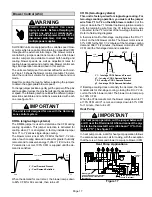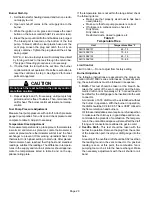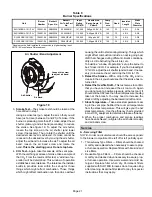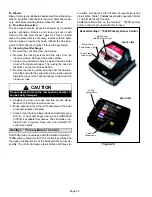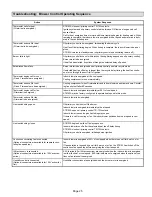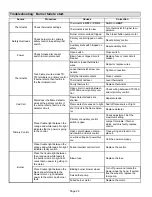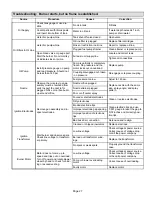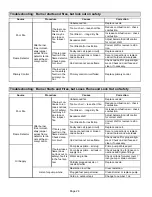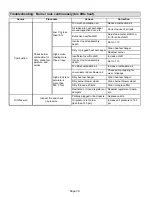
Page 25
Troubleshooting: Blower Control Operating Sequence
Action
System Response
Thermostat calls for heat.
(W terminal is energized.)
ST9103A closes oil primary control TR−TW contacts.
Ignition system and oil primary control start the furnace. Oil flows as long as cad cell
senses flame.
Call for heat energizes burner motor and blower ramping begins for heating mode. When
ramping is complete, the indoor blower is energized at heat speed and warm air is deliv-
ered to the controlled space.
Thermostat ends call for heat.
(W terminal is de−energized.)
Oil primary control is de−energized, terminating the burner cycle.
Heat fan off delay timing begins. When timing is complete, the indoor blower is de−ener-
gized.
ST9103A returns to standby mode (oil primary control and circulating fan are off).
Burner fails to light.
Oil primary control locks out within lockout timing (timing depends on oil primary control).
Burner motor is de−energized.
If heat fan has started, it continues through the selected delay off period.
Established flame fails.
Burner motor is de−energized and oil primary control goes into recycle mode.
If selected heat fan off delay is longer than the recycle delay timing, the heat fan contin-
ues to run through the next trial for ignition.
Thermostat begins call for cool.
(G and Y terminals are energized.)
Indoor blower is energized at the cool speed.
Cooling compressor turns on immediately.
Thermostat ends call for cool.
(G and Y terminals are de−energized.)
Cooling compressor turns off immediately and indoor blower speed ramps down. Circulat-
ing fan shuts off after 60 seconds.
Thermostat begins call for fan.
(G terminal is energized.)
Indoor blower is energized immediately at 50% of cool speed.
ST9103A may be factory−configured to operate heat speed in this mode.
Thermostat ends call for fan.
(G terminal is de−energized.)
Indoor blower is de−energized.
Limit switch string opens.
Oil primary control shuts off the burner.
Indoor blower is energized immediately at heat speed.
ST9103A opens oil primary control TR−TW contacts.
Indoor blower runs as long as limit string stays open.
If there is a call for cooling or fan, the indoor blower switches from heat speed to cool
speed.
Limit switch string closes.
ST9103A begins heat fan off delay sequence.
Indoor blower turns off after the selected heat fan off delay timing.
ST9103A closes oil primary control TR−TW contacts.
Oil primary control is energized, initiating burner ignition.
Continuous circulating fan is connected.
(Optional connectors are available for separate circu-
lating fan speed tap.)
Indoor blower is energized at 50% of cool speed when there is no call for heat, cool or
fan.
If fan operation is required by a call for heat, cool, or fan, the ST9103A switches off the
continuous fan speed tap before energizing the other fan speed.
IAQ accessory is connected.
(Optional connectors are available for 120 Vac acces-
sories.)
EAC terminals (for IAQ accessories) are energized when the indoor blower is energized
in either the heat or cool speed. EAC terminals are
not
energized when the optional con-
tinuous fan terminal is energized.
Humidity control is connected.
(Optional connectors are available for 120 Vac humidi-
fier.)
Humidifier connections are energized when the burner motor is energized.







